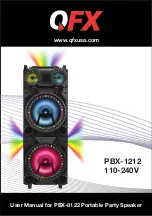
Most DLS speakers have 4-pole terminals
allowing bi-wiring. This requires two
cables for each speaker and gives an
audible improvement. Remove the
connectors between low and high sections
of the terminal and connect according to
fig. 2.
Power handling
DLS recommends using amplifiers within a
specific power range. However, the most
important thing is that the amplifier has
sufficient power reserves for handling
peaks and transient in the music signal
The power rating figure of a loudspeaker
is a very inprecise figure. Since the energy
in the music signal varies, neither peak
nor average value is relevant. A power
rating of e.g. 100W RMS says only that
you can play a continuous tone of 1kHz at
this output. It does not mean that you
can turn the volume all the way up on a
100W amplifier and expect clear sound
and healthy speakers.
The greatest danger to a loudspeaker is
distorded signal. Distorsion in the low
frequency range produces overtones in
the entire spectrum, with an energy that
can easily damage the tweeter units. And
since a more powerful amplifier can play
louder without distorsion, we have the
paradox that it is a greater risk to damage
speakers by playing loud with a smaller
amplifier.
Caution!
If you hear distortion when you increase
the volume this is normally a sign of
overloading the amplifier and you should
immediately reduce the output level.
Use of loudness, bass or treble boost
increases the risk for harmful distortion
in the amplifier. We recommend that you
use these controls with care.
AMPLIFIER
SPEAKER TERMINAL
fig. 2
Magnetic shielded speakers
Magnetic shielded speakers, such as
Center channel speakers are magnetically
shielded and can safely be placed directly
on, under or alongside your video (TV)
monitor. A small number of televisions are
hyper sensitive to magnetic fields. If you
notice any picture distortion, we recom-
mend that you move the speaker a few
centimetres forth or back, or distance the
speaker a few centimetres. These small
changes in the position often are enough
to cure the problem.
Connections
We recommend the use of heavy gauge
loudspeaker cables of high quality.
To reduce the effect the cable has on the
speaker, the impedance of the cable at all
frequencies should be lower than 0.2
Ω
. At
high frequency the inductive component of
the cables impedance can
dominate over the DC resistance. Ask
your dealer for the best cable for your
needs.
Make sure to turn off all amplifiers
before connecting your new speaker to
your Hi-Fi system.
Connect the cable to the terminal. Use the
marking of the cable to ensure that the red
or ”+” mark of the amplifier is connected to
the ”+” side of the terminal, also marked
with red.






















